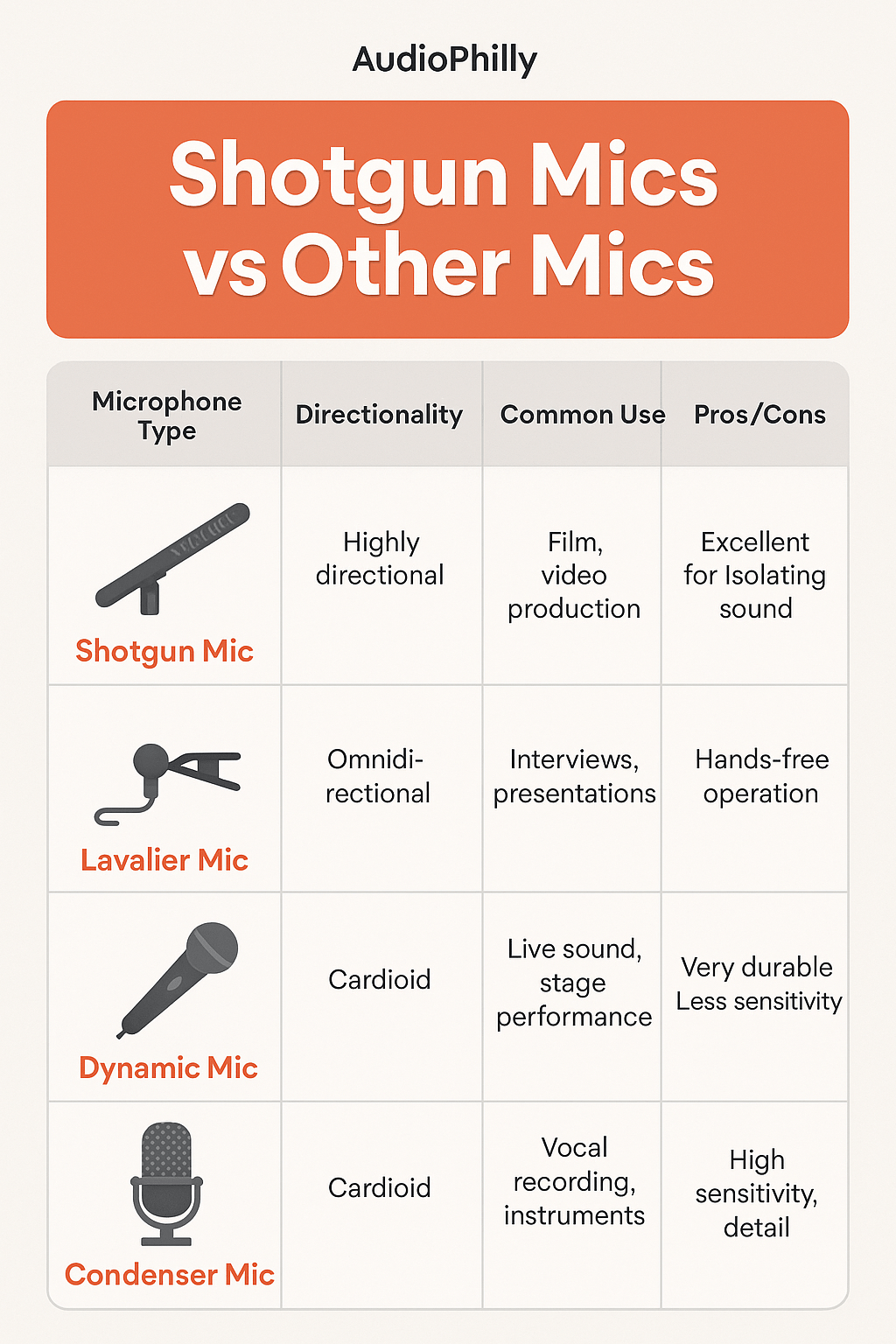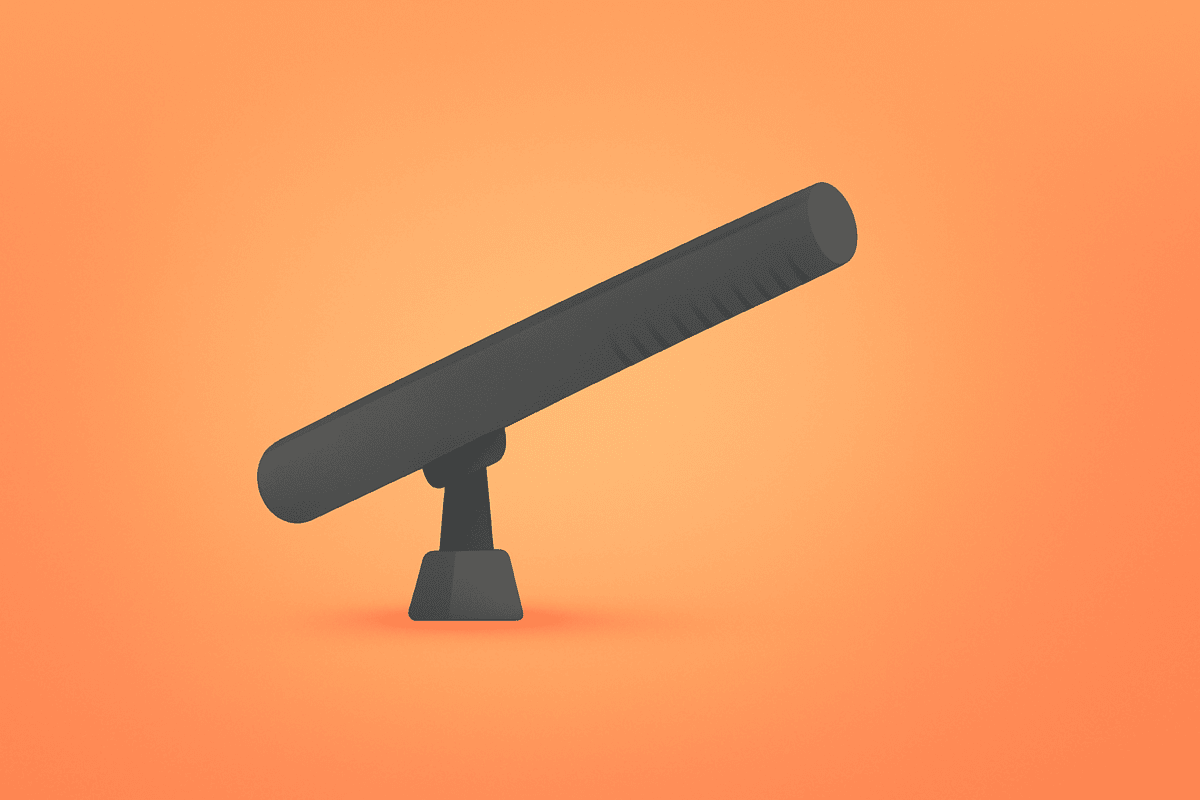If you’re diving into the world of audio, especially for video or outdoor recording, you’ve probably heard the term shotgun mic tossed around. But what exactly is it? And why do filmmakers, documentarians, and sound pros swear by them?
Let’s break it all down in simple terms—no engineering degree required.
What Is a Shotgun Microphone, Anyway?
A shotgun microphone is a super-directional mic designed to capture sound from a specific direction—usually right in front of it—while minimizing everything else. Picture it like a laser pointer for sound: whatever it’s aimed at is what it’s going to pick up the most.
You’ll often spot them on top of boom poles, camera rigs, or even pointed at wildlife in nature documentaries. They’re long, tube-shaped, and built for focus.

What Makes a Shotgun Mic Unique?
1. Physical Characteristics
First thing you’ll notice: shotgun mics are long and narrow. That’s no accident—it’s all part of the design that helps them pick up sound in a tight beam.
2. Acoustic Design
Inside that long barrel is a series of tiny slots or vents along the side. These work with a special acoustic design called an interference tube. It helps cancel out off-axis sounds—like chatter from the sides—while reinforcing what’s right in front.
3. Polar Pattern and Directionality
Most shotgun mics use what’s called a supercardioid or lobar polar pattern. All that means is: they’re super focused straight ahead, with a bit of sensitivity to the rear, but very little to the sides. This tight directionality is key to their usefulness in noisy environments.
So How Does a Shotgun Mic Actually Work?
Here’s the fun part.
1. Sound Wave Interference
Shotgun mics use phase cancellation to reduce off-axis sound. The side vents let sound enter from different angles and distances. If it’s not coming from the front, the mic’s design helps those sounds cancel each other out. It’s like noise gate magic built into the mic itself.
2. Natural Noise Rejection
Because of that directional design, shotgun mics naturally reject background noise. Not all of it—but enough to make a difference when you’re trying to isolate voices or specific sounds in the middle of chaos.
3. Compared to Other Mics
Unlike a lavalier (clip-on) or omni mic that hears everything around it, a shotgun mic is picky. That makes it ideal when you don’t want to hear the whole environment—just your subject.
When Should You Use a Shotgun Mic?
1. Film & Video Production
This is their sweet spot. Whether you’re filming a dialogue scene or capturing ambient sounds on set, a shotgun mic mounted to a boom is the standard for clean, focused audio.
2. Documentary Filmmaking
Need to capture spontaneous moments from a distance? Shotgun mics let you record voices and action without shoving a mic in someone’s face.
3. Wildlife and Nature Recording
You can’t exactly ask a bird to speak up. Shotgun mics let you capture distant animal sounds without disturbing them—or getting too close.
4. Live Events & Sports
In stadiums or on the sidelines, shotgun mics help focus in on players, announcers, or moments in the crowd, while keeping the chaos in check.
5. Indoor vs. Outdoor
Shotgun mics shine outdoors, where sound reflections are minimal. Indoors, though, they can sometimes be tricky due to echo and reverb. You’ll need to be careful with placement and room acoustics.
How to Choose the Right Shotgun Mic
1. What Matters Most?
Think about your main use case. Will you be shooting interviews? Nature sounds? You’ll want to match the mic’s directionality and pickup range to your environment.
2. Budget
You don’t need to spend thousands. There are solid options in the $100–$300 range for beginners and hobbyists. Just be aware—cheaper mics may require more post-processing or cleaner environments to sound their best.
3. Look at the Specs
Key things to check:
- Frequency response (how naturally it picks up voices)
- Self-noise (lower is better)
- Max SPL (important if you’re recording loud sources like motorsports or concerts)
- Power type (some need phantom power, others run on batteries)
Tips for Getting the Best Sound
1. Mount It Right
Boom poles are great if someone else is helping. If you’re solo, try mounting the shotgun mic on-camera or with a stand, aimed just above or below your subject’s mouth—not directly at their face.
2. Block That Wind
A foam cover is the bare minimum, but for outdoor use, invest in a proper windscreen or “deadcat” muff. Wind noise ruins takes fast.
3. Watch Your Angles
Remember, shotgun mics don’t hear around corners. If you’re even slightly off-axis, you might lose clarity. Always aim carefully and monitor your sound if possible.
Wrapping It Up
To recap: shotgun mics are your go-to tool when you need focused, directional audio—especially in uncontrolled environments. Whether you’re filming a short movie or stalking songbirds in the forest, these mics help you cut through the noise and hone in on what matters.
As audio gear keeps evolving, shotgun mics are only getting more compact and more capable. So if you’re serious about leveling up your sound game, getting to know how they work is a huge step in the right direction.
Got your sights set? Good—now point and shoot (sound, that is).

Leave a Reply